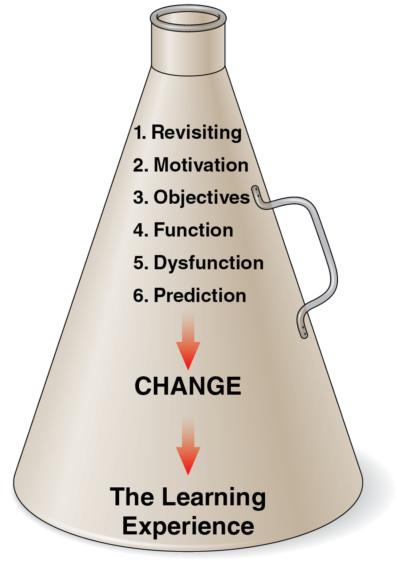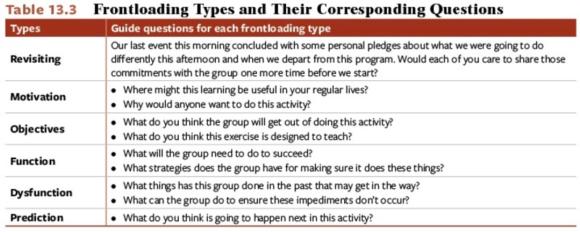Frontloading
This is an excerpt from Effective Leadership in Adventure Programming 3rd Edition Ebook With Field Handbook by Simon Priest & Michael Gass.
Frontloading involves asking questions before the activity or learning experience that allow clients to change their behaviors in the experience. "Front" indicates that the facilitation takes place up front, or before the experience. "Loading" refers to the fact that the learning is loaded together, or emphasized, in combination beforehand. In summary, frontloading means punctuating the key learning points in advance of the adventure experience rather than reviewing or debriefing learning after. Frontloading typically utilizes one or more of the following six types of questions: revisiting, objectives, motivation, function, dysfunction, and prediction as shown in figure 13.3.

Figure 13.3 The frontloading bullhorn: single questions asked before the learning experience.
The excitement of adventure activities can help a group focus intensely on completing a task, distracting it from the changes it is there to accomplish. The revisiting question reminds group members of the behaviors they pledged to perform after the last activity. Just before the new activity begins and after you have explained the task, you can pose a single question: "One more thing. What were the commitments the group made last time?" This brief question brings the previous answers to the "do things differently next time" question to the front of clients' minds so they are more likely to act on their revisited affirmations during the activity.
Besides a revisiting question, you can ask other types of frontloading questions in combination or alone. Objective questions ask about the aims of the activity and what can be learned or gained from the experience. Motivation questions ask why experiencing the activity may be important and how learning relates to daily life. Function questions ask what behaviors will help bring about success and how the group may optimize them. Dysfunction questions ask what behaviors will hinder success and how the group can avoid or overcome them. Prediction questions ask clients to imagine what is going to happen. These six question types for frontloading are like the six question types used as filters in the funneling model. In fact, look again at figures 13.2 and 13.3; turn one upside down and you have the other. The difference between frontloading and funneling questions is timing: when you ask the questions. Frontloading questions come before and funneling questions come after the experience.
The six question types can be illustrated with the wall activity. This activity includes a 12- to 14-foot (three- to four-meter) structure with a ledge on the back side. The group is challenged to pass its members up the front side and over the top. One difficult aspect of getting over the wall is getting the first person up. Generally, the crux of the problem is getting the last person over the wall with no one remaining below to lift him or her. In a typical briefing before the activity, you introduce the problem by mentioning the group goal of getting everyone over the wall; task constraints, such as not holding onto the edges or not using props other than the available resources; safety rules, including no more than two people on the ledge at a time and no holding people upside down; safety procedures, such as removing jewelry and always spotting; and the time limit, such as 30 minutes, including planning. Many programs then give clients the right to pass and be challenged by choice; some programs employ helmets and harnesses to prevent head injury or torn clothing; and a few programs include handicaps, such as blindfolds or muting. During the briefing, you could add one or more of the frontloading questions outlined in table 13.3.

Frontloading can take place either before or after the logistical briefing. You may even occasionally include frontloading within that briefing. However, we caution you about too much frontloading. The average person can juggle five to nine thoughts at once (Miller, 1956). A typical adventure activity briefing has a half dozen or so important points clients must retain for safety and accuracy. Adding more than two or three extra points by frontloading can overload clients, possibly causing them to forget the key points they need. Most importantly, overusing frontloading can create a dependency on the facilitator; clients learn to rely on you to do the thinking for them. Even so, when used in moderation, say for 10 percent of the activities, frontloading can be an effective facilitation tool.
Learn more about Effective Leadership in Adventure Programming, Third Edition, With Field Handbook.
More Excerpts From Effective Leadership in Adventure Programming 3rd Edition Ebook With Field HandbookSHOP

Get the latest insights with regular newsletters, plus periodic product information and special insider offers.
JOIN NOW


